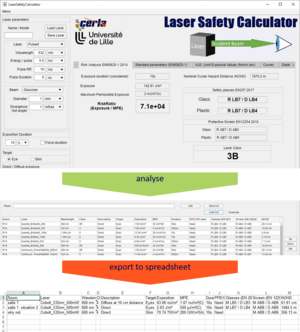The Laser Safety Calculator software has been developed at the centre to accompany the laser risk assessment carried out at each stage of experimentation. It quickly performs the standard calculations of exposure and maximum permissible exposure, making it possible to deduce the risk of a laser installation. It also calculates the need for protective laser glasses and screens. A final option lets you export your various calculations and analyses as a spreadsheet file for rapid incorporation into your DUERP and prevention plan.
Only the Windows version is currently available. You are free to virtualise a Windows machine in another environment.
This executable has been developed in Matlab and requires the Matlab runtime to be installed. The installer will prompt you to download the correct version, so an internet connection is required for installation.
This software is an aid to risk analysis, but does not make the user a competent Laser Safety Officer. The standards are complex and must be adapted to the situation being studied. For this reason, neither CERLA nor the author of the code can be held responsible for misuse of the software or misinterpretation of the results.
To help you use the software correctly, a help file is available in French (a pdf reader must be installed on the machine). The centre also strongly recommends that you take laser safety training at the RSL (CNRS), PCSL (private training organisations) or CSL (CERLA) level in order to make the best use of this software.
In addition, despite all our development efforts, there may still be a few bugs or situations not envisaged by the author that could lead to false / inapplicable / unsuitable results. If you find a bug, please let us know: LSC contact bug
Acknowledgements: The author would like to thank the “GT sécurité optique du Réseau Optique et Photonique du CNRS”, the “Commission Nationale Sécurité Optique et Laser de Photonics France”, the CNPS (CNRS) and, of course, all the Laser Safety Officers at the University of Lille for the many exchanges and in-depth discussions on laser safety issues that contributed to the development of this software.
